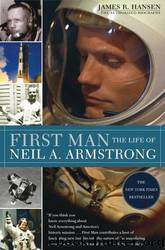First Man: The Life of Neil A. Armstrong by James R. Hansen

Author:James R. Hansen
Language: eng
Format: mobi, epub
Tags: Technology & Engineering, Space Flight to the Moon, Creative Ability, Science & Technology, Modern, Astronauts, General, United States, Astronautics, Biography, Biography & Autobiography, Military, History, 20th Century, Aeronautics & Astronautics, Psychology
ISBN: 9780743256315
Publisher: Simon & Schuster
Published: 2005-10-15T00:00:00+00:00
PART SEVEN
ONE GIANT LEAP
He who would bring back the wealth of the Indies, must carry the wealth of the Indies with him.
—INSCRIPTION ON THE FAÇADE OF UNION STATION, WASHINGTON DC
Did he take something of Karen with him to the Moon? Oh, I dearly hope so.
—JUNE ARMSTRONG HOFFMAN
CHAPTER 27
Outward Bound
For Armstrong, Collins, and Aldrin, going into space actually commenced back in the crew quarters three and a half hours before liftoff, shortly after 6:00 A.M., when technicians snapped the astronauts’ helmets down onto their neck rings and locked them into place. From that moment on, the crew of the first Moon landing breathed no outside air. They heard no human voice other than that piped in electronically through the barrier of their pressure suits. They saw the world only through the veneer of their faceplates, and could smell, hear, feel, or taste nothing but that which modern technology manufactured for them inside their protective cocoon.
For Armstrong, the isolation was more familiar than it was for his mates. As a test pilot back at Edwards, he had grown accustomed to the confinement of pressurized flight suits. In comparison to the partial pressure suits and headgear he had donned for flying zooms in the F-104 or going to the edge of space in the X-15, the Apollo suit was downright roomy and easy to maneuver.
Still, as the crew of Apollo 11 left the Manned Spacecraft Operations Building at 6:27 A.M. and paraded in their protective yellow galoshes into the air-conditioned transfer van that was to transport them eight miles to Launchpad 39A, every tissue of their being, every nerve fiber, every brain cell, every recess of their inner space, acknowledged that they had left the ordinary, commonsense realm of nature and had entered the totally artificial environment that would sustain them in outer space.
As best as they could manage for the past weeks and months, the three astronauts had ignored the steady buildup around their mission. “We were running on a pretty fast track,” relates Armstrong. “There were so many things to do, and reading newspapers and watching television was not high on our list.”
Going into the mission, Neil, Mike, and Buzz possessed great confidence in the Saturn rocket, but one could never be sure about any rocket’s performance—not even the massive machine designed by von Braun’s accomplished team of rocketeers at NASA’s Marshall Space Flight Center in Alabama. “It was certainly a very high-performance machine,” Armstrong asserts. “It was not perfect, though. Indeed, in the flight after ours, there would be problems.” A lightning strike thirty-six seconds after Apollo 12’s liftoff resulted in a complete, albeit temporary, electrical failure inside the spacecraft. The failure was not the fault of the rocket except for the fact that an ionized plume from the rocket made the entire vehicle more electromagnetically attractive.
Another concern about the rocket lay in the fact that the Saturn V had come to life so quickly. The phenomenally fast pace of its development resulted from the strategy of “all-up testing,” a new NASA R&D philosophy championed by Dr.
Download
First Man: The Life of Neil A. Armstrong by James R. Hansen.epub
This site does not store any files on its server. We only index and link to content provided by other sites. Please contact the content providers to delete copyright contents if any and email us, we'll remove relevant links or contents immediately.
Learning SQL by Alan Beaulieu(6237)
Weapons of Math Destruction by Cathy O'Neil(6219)
Digital Minimalism by Cal Newport;(5704)
iGen by Jean M. Twenge(5385)
Sapiens by Yuval Noah Harari(5324)
The Age of Surveillance Capitalism by Shoshana Zuboff(4247)
Elon Musk by Ashlee Vance(4084)
Thing Explainer by Randall Munroe(3910)
Apollo 8 by Jeffrey Kluger(3668)
Future Crimes by Marc Goodman(3565)
The Science Book (Big Ideas Simply Explained) by DK(3253)
Who Can You Trust? by Rachel Botsman(3111)
The Innovators: How a Group of Hackers, Geniuses, and Geeks Created the Digital Revolution by Walter Isaacson(2997)
I Live in the Future & Here's How It Works by Nick Bilton(2960)
Infinite Energy Technologies by Finley Eversole(2953)
Steve Jobs by Walter Isaacson(2858)
Dawn of the New Everything by Jaron Lanier(2751)
Chernobyl by Serhii Plokhy(2514)
Ben Franklin's Almanac by Candace Fleming(2492)
